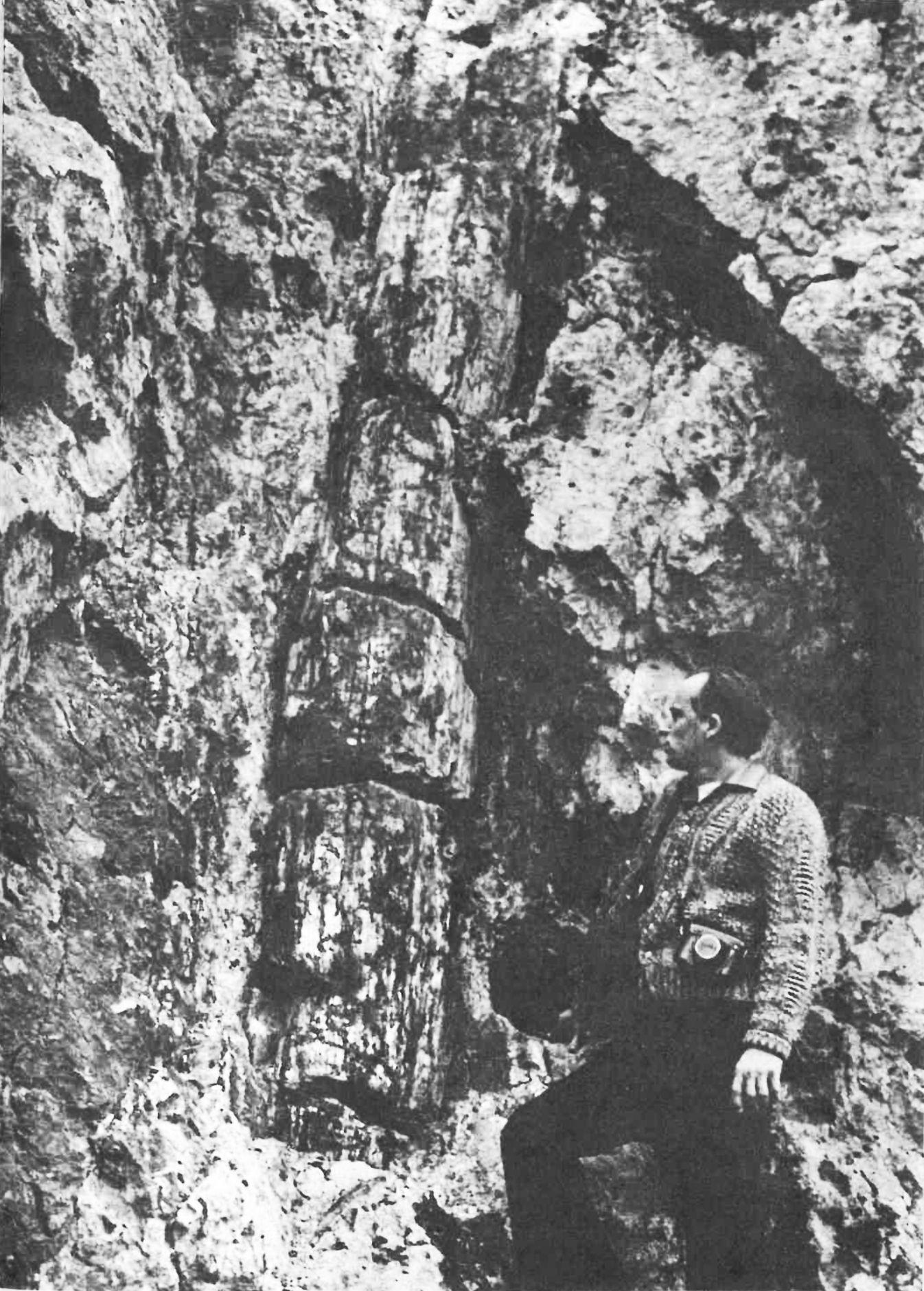©Copyright 2018 GEOSCIENCE RESEARCH INSTITUTE
11060 Campus Street • Loma Linda, California 92350 • 909-558-4548

STUDY IN THE JOHN DAY COUNTRY
by
Dalton D. Baldwin
Division of Religion
Loma Linda University
When information from science and sacred history are studied together, one’s conclusions differ from those deduced when each is studied alone. The purpose of the Bible-Science Subcommittee is to explore the relationship of these two avenues of information. Previous reports of this group’s activities are given in Origins 1:37-39; 2:44-45. The May 1975 meeting was held in Prineville, Oregon, near the John Day Country, famous for its fossil mammals and plants (Figure 1).

FIGURE 1. Dr. Dwain L. Ford examining a petrified upright tree trunk in the Triassic Clarno Formation near Hancock Park in central Oregon. His right hand rests in the cast of a horizontal tree trunk.
Three participants at the conference had made extensive studies of the John Day Country. Stuart Nevins (a guest from the Institute for Creation Research) who had already published on the geology of the area provided particularly valuable assistance throughout the conference. Harold Coffin, from the Geoscience Research Institute, described the geology of the Pacific Northwest as an orientation for a field trip. Ervil Clark of the Biology department at Pacific Union College exhibited a number of specimens which he had collected in the area and discussed the significance of their depositional environments. During a full-day field trip through the John Day Country, problems were faced with candor, and evidence was cited which supports transport of many fossil remains rather than growth at the site of deposition.
A number of papers at the conference were based on material reported in past meetings of the committee. Eleven of the studies were presented by individuals who received their advanced education in the area of the empirical sciences. Leonard Brand of the Biology department at Loma Linda University with pictures and other evidence showed that fossil vertebrate footprints in the Coconino Sandstone of the Grand Canyon are similar to those made in very wet sand or under water. This evidence is more consistent with a flood model than with the commonly accepted wind-blown sand model. Dwain L. Ford, Dean of the College of Arts and Sciences, Andrews University, reviewed various theories regarding the origin of evaporites (minerals formed by evaporation) and suggested a model which could account for the formation of major salt beds within the context of a flood model. Harold Coffin reported on accumulating evidence from directional orientation which suggests that many fossil remains were transported rather than growing in the location where they are now found. Three computer studies were presented by Ray Hefferlin of the Physics department at Southern Missionary College. By using a computer terminal at the meeting in Prineville, participants were able to determine the quantitative distribution of water on the earth under postulated conditions. His other reports dealt with variations in C-14 production with different creation and flood models.
Ariel A. Roth, chairman of the Bible-Science Subcommittee, surveyed seven lines of evidence which support a flood model: reduced provinciality in the fossil record, spores of land plants in the lowest Paleozoic sediments, prevalence of turbidites, extent of sedimentary deposit, paucity of erosional features at unconformities, paucity of local depositional features, and inconsistencies of various time clocks. Harold James of the Geoscience Research Institute reported on sedimentary characteristics of some Miocene deposits in Colombia, South America, and the importance of these characteristics in interpreting the past. Ivan Holmes, Associate Dean of Arts and Sciences at Loma Linda University, and Richard Martin, a student, described X-ray diffraction analysis of alternating mineral layers from the Petrified Forests north of Specimen Creek in Yellowstone National Park. Arthur Chadwick of the Biology department at Loma Linda University suggested a test to determine if trees of the Yellowstone Petrified Forests grew in place or were transported. He proposed that if large roots often end abruptly, this would constitute critical evidence against growth at the site of deposition. He also described logistic problems encountered in searching for such evidence. James Riggs of the Physics department at Loma Linda University discussed the difficulties of developing a model which can account for the cooling of batholiths with an approximately 6000-year chronology for life on the earth.
Three of the papers were written by those who approached the theme of the committee from a theological viewpoint. Dalton Baldwin of the Division of Religion at Loma Linda University suggested that ideas rejecting a scientific approach to religion may be seen as harmonious with those advocating a scientific approach to religion, if the rejected science is found to be science “falsely so-called” and the recommended science is true science. Raymond F. Cottrell, secretary of the Bible-Science Subcommittee, surveyed recent developments in astrophysics and cosmology and discussed their relationship to origins. Gerhard Hasel, Assistant Dean of the Theological Seminary at Andrews University, presented a paper on Genesis cosmology which showed the striking differences from other cosmologies of the Near East. He placed emphasis on creation as the absolute point of origin, God Himself as creator, creation by divine fiat, and the limitation of the creation account to this earth.
Considerable time was devoted to the development of a statement of belief with respect to creation. The chairman of the committee had prepared a questionnaire designed to pool the judgment of the participants regarding various factors which might be included in the statement. The Geoscience staff was requested to draw up a statement reflecting the oral and written responses to the questionnaire for presentation at the next meeting.
The stimulation of the carefully prepared papers and the subsequent active discussions challenged the participants to further study in preparation for the forthcoming meeting to be held at Price, Utah, where extensive coal deposits are found.